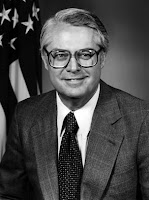Senator Chuck Grassley (R-Iowa) pays tribute to the memory of Ernie Fitzgerald in a 23 minute floor speech the Senate Floor, 6 February 2019. (This is second posting about the late Ernie Fitzgerald; the first can be found at this link.)
The text of Grassley’s tribute can be found at this link.
See also this excellent remembrance by my friend and long time Pentagon watcher Andrew Cockburn in Counterpunch.
FEBRUARY 6, 2019
by ANDREW COCKBURN, Counterpunch, 6 February 2019
Ernie Fitzgerald, who died on January 31, always tried to be optimistic. “That’s where the Joint Chiefs will make their last stand when the taxpayers finally storm the building,” he would say, pointing to the hot dog stand at the center of the Pentagon’s inner greensward. The Chiefs would have richer territory to defend today – hot dogs have given way to an Au Bon Pain eatery, and defense spending has soared to heights even beyond the levels decried, and whenever possible sabotaged, by Ernie as he waged bureaucratic warfare from his guerrilla headquarters on the fifth floor.
That was long after he had been sacked from his position as a senior air force cost management official on the direct orders of Richard Nixon (“get rid of that son of a bitch”) for testifying to congress that the air force was facing, accepting, and concealing a $2 billion cost overrun on the C-5A transport plane being built by Lockheed. Ernie sued Nixon and the cronies involved in the illegal firing, fought the case all the way to the supreme court, won his job back, sued again when the air force nevertheless refused him proper exercise of his responsibilities, and won again.
Even though the air force did its best to keep him well away from further official probes of major contractors’ larcenous operations, Ernie nevertheless not only inspired fellow whistleblowers and helped organize an effectiv system for promoting their revelations, but also, being a propagandist of genius, instilled in the public mind a perception of defense spending as systemized rip-off.
The inspiration benefited not only whistleblowers – he called it “committing truth” – but also journalists, as I can attest, having been the recipient of countless calls that invariably began with “this is o-o-ld Fitzgerald” in his beautifully modulated Alabama drawl. But beyond such direct contacts, Ernie conceived and encouraged an organization, The Project on Military Procurement to broadcast revelations of Pentagon malfeasance while protecting the leaker, often via the cover of his potent contacts on Capitol Hill. The Project subsequently evolved into the ongoing and potent Project on Government Oversight.
Ernie’s particular stroke of promotional insight was that, though the public’s eyes may glaze over when informed that some weapons system or other was costing billions more than initially advertised, they would readily understand the fraud of a toilet seat priced at $640, or a $435 hammer, obscenities that he unearthed and publicized, and that generated the appropriate outrage. His hope was that such examples would lead to the understanding that grotesquely overpriced bombers and missiles were simply collections of such spare parts “flying in close formation.”
More fundamentally, Ernie’s experiences in the Pentagon weapons-buying culture lead him to the essential truth that outrageous weapons costs are not merely manifestations of corruption or incompetence, but actual official policy. In his terrific books, High Priests of Waste and The Pentagonists (he wrote as well as he talked) he laid out an ironclad case for this proposition, including unguarded admissions by high officials such as Dr. Eugene Fubini, in his time a hugely influential Pentagon advocate for hi-tech (and invariably hugely expensive) weaponry, who stated publicly that defense spending could never be cut because “We have an arsenal economy, and we just can’t change it without violent dislocation.” Air Force General “Zeke” Zoekler went so far as to explain, in response to Ernie’s efforts to curb costly inefficiencies in a vast program supervised by the general, that so far as defense procurement was concerned, “inefficiency is national policy” necessary for the attainment of “social goals.”
Given that politicians and the universe of public opinion manipulators readily accept and tout this notion, regardless of whether we are thereby provided with an effective defense, or whether there is any threat against which we need to defend, it is hardly surprising that the military-industrial-complex enjoys almost unchallenged political power, a fact that Ernie well understood. As he remarked to me in the aftermath of the 1980 election, in which both parties had held out promises of rivers of gold to the military in hopes of endorsement by the MIC, “The Joint Chiefs just auctioned off the presidency from the battlements of the Pentagon.” Today’s world, in which our president’s agenda, generally marked by rapine and pillage, has proceeded almost without effective challenge except when he contemplated cutting the defense budget (Trump’s effort to cut it to $700 billion from the 2020 tab was almost immediately quashed) or halting foreign military engagements (necessary excuses for budget nourishment) bely Ernie’s optimism regarding an eventual taxpayer revolt. But he never gave up fighting. We have lost a great patriot.
More articles by:ANDREW COCKBURN
Andrew Cockburn is the Washington editor of Harper’s Magazine. An Irishman, he has covered national security topics in this country for many years. In addition to publishing numerous books, he co-produced the 1997 feature film The Peacemaker and the 2009 documentary on the financial crisis American Casino. His latest book is Kill Chain: The Rise of the High-Tech Assassins (Henry Holt).






